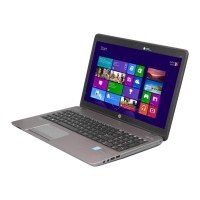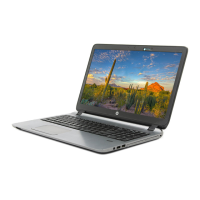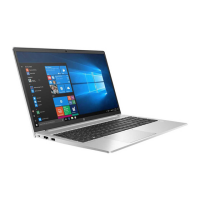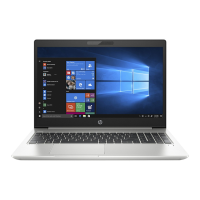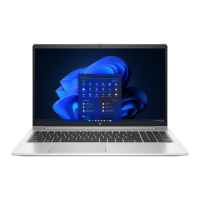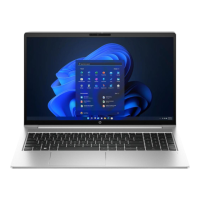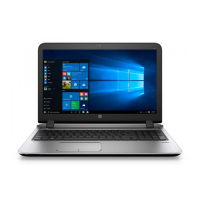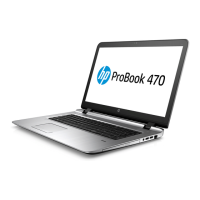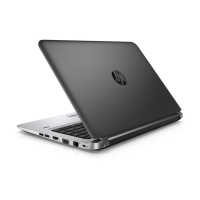Do you have a question about the HP ProBook 450 G3 and is the answer not in the manual?
Identifies and describes the computer's display components and features.
Details components located on the top surface of the notebook, including the touchpad.
Explains the function and status of various indicator lights on the computer.
Describes the power button, speakers, and fingerprint reader functionality.
Identifies and explains the function of special keys like ESC, FN, Windows, and Function keys.
Describes components located on the front of the computer, such as drive lights and card readers.
Details components on the bottom of the notebook, including service doors and battery latches.
Identifies ports and components located on the left side of the computer.
Identifies ports and components located on the right side of the computer.
Explains the purpose and location of various labels affixed to the computer.
Provides an exploded view and part numbers for major internal computer components.
Lists parts included in the Plastics Kit, such as service doors and inserts.
Details parts related to the display assembly, including bezels, hinges, and webcam modules.
Lists the various cables included in the Cable Kit and their functions.
Details specifications and part numbers for hard drives and optical drives.
Lists various miscellaneous parts such as AC adapters, power cords, and cases.
Lists the essential tools needed for component removal and replacement procedures.
Provides important guidelines and precautions for disassembly and assembly.
Offers guidance on handling and routing computer cables and connectors carefully.
Details precautions for handling fragile storage drives to prevent damage.
Explains electrostatic discharge (ESD) and measures to prevent damage to components.
Provides instructions for safely packaging and transporting electronic equipment.
Outlines recommended practices for setting up an ESD-safe workstation.
Describes necessary grounding equipment and protective materials for preventing ESD.
General instructions and notes for replacing customer-accessible parts successfully.
Step-by-step instructions for removing and replacing the computer's battery.
Procedures for removing the small and large service doors to access internal components.
Instructions for removing and replacing the computer's optical drive.
Detailed steps for removing and replacing the computer's hard drive.
Procedures for updating the BIOS and replacing memory modules.
Instructions for removing and replacing the WLAN/Bluetooth combo card.
Steps for removing and replacing the WWAN module.
Procedures for removing and replacing the M.2 solid-state drive.
Detailed steps for removing and replacing the computer's keyboard.
General instructions for authorized service provider parts replacement.
Comprehensive steps for removing and replacing the top cover assembly.
Procedures for removing and replacing the fingerprint reader assembly.
Steps for removing and replacing the power button board.
Instructions for removing and replacing the USB/audio board.
Procedures for removing and replacing the function board.
Steps for removing and replacing the card reader board.
Instructions for removing and replacing the computer's fan.
Procedures for removing and replacing the optical drive connector cable.
Steps for removing and replacing the battery connector cable.
Detailed procedures for removing and replacing the system board.
Instructions for removing and replacing the real-time clock (RTC) battery.
Procedures for removing and replacing the speaker assembly.
Steps for removing and replacing the heat sink assembly for thermal management.
Detailed instructions for removing and replacing the entire display assembly.
Procedures for removing and replacing the power connector and cable.
Guide to accessing and navigating the Computer Setup (BIOS) utility.
Instructions for resetting BIOS settings to their factory defaults.
Information on how to check for and update the system's BIOS.
Steps for safely downloading a BIOS update from the HP website.
Explains how to manage boot device order and preferences for multiple operating systems.
Information on HP Sure Start technology for BIOS protection and recovery.
Guide to accessing and navigating the Computer Setup (BIOS) utility in Windows 8.1.
Instructions for resetting BIOS settings to their factory defaults in Windows 8.1.
Information on how to check for and update the system's BIOS in Windows 8.1.
Steps for safely downloading a BIOS update from the HP website for Windows 8.1.
How to manage boot device order and preferences in Windows 8.1.
Information on HP Sure Start technology for BIOS protection in Windows 8.1.
Guide to accessing and navigating the Computer Setup (BIOS) utility in Windows 10.
Instructions for resetting BIOS settings to factory defaults in Windows 10.
Information on checking and updating the system's BIOS in Windows 10.
Steps for safely downloading a BIOS update from the HP website for Windows 10.
How to dynamically select a boot device using the F9 prompt in Windows 10.
How to configure Trusted Platform Module (TPM) settings in the BIOS.
Information on HP Sure Start technology for BIOS protection in Windows 10.
Instructions for initiating Computer Setup (BIOS) on Ubuntu Linux.
Guide to navigating and selecting options within the BIOS utility for Ubuntu.
Steps for downloading and preparing the UEFI diagnostics tool on a USB drive.
How to create recovery media and perform system backups in Windows 7.
Guidance on regularly backing up personal files and system settings.
Procedures for recovering the system using various tools and media.
Guidance on creating backups and system repair media in Windows 8.1.
Procedures for recovering the system using Windows tools or recovery media.
Methods for creating HP Recovery media and backups in Windows 10.
Options for system recovery, including using HP Recovery Manager and media.
Instructions for creating restore media and system backups in Ubuntu.
Guidance on regularly backing up computer files and personal information.
Procedures for repairing or restoring the computer to its original state in Ubuntu.
Detailed technical specifications for the computer's dimensions, weight, and power.
Technical details specific to the 15.6-inch display panel.
Technical specifications for various hard drive capacities and types.
Technical specifications for M.2 solid-state drives.
Technical specifications for the DVD±RW SuperMulti DL optical drive.
Technical specifications for the Blu-ray ROM DVD±RW SuperMulti DL optical drive.
Technical specifications for the DVD-ROM optical drive.
Explains the types, purpose, and data handling of nonvolatile memory in HP PCs.
Addresses common questions regarding BIOS settings, UEFI, and memory.
General requirements for power cord sets applicable globally.
Specific power cord set requirements and certifications for various countries.
Identifies and describes the computer's display components and features.
Details components located on the top surface of the notebook, including the touchpad.
Explains the function and status of various indicator lights on the computer.
Describes the power button, speakers, and fingerprint reader functionality.
Identifies and explains the function of special keys like ESC, FN, Windows, and Function keys.
Describes components located on the front of the computer, such as drive lights and card readers.
Details components on the bottom of the notebook, including service doors and battery latches.
Identifies ports and components located on the left side of the computer.
Identifies ports and components located on the right side of the computer.
Explains the purpose and location of various labels affixed to the computer.
Provides an exploded view and part numbers for major internal computer components.
Lists parts included in the Plastics Kit, such as service doors and inserts.
Details parts related to the display assembly, including bezels, hinges, and webcam modules.
Lists the various cables included in the Cable Kit and their functions.
Details specifications and part numbers for hard drives and optical drives.
Lists various miscellaneous parts such as AC adapters, power cords, and cases.
Lists the essential tools needed for component removal and replacement procedures.
Provides important guidelines and precautions for disassembly and assembly.
Offers guidance on handling and routing computer cables and connectors carefully.
Details precautions for handling fragile storage drives to prevent damage.
Explains electrostatic discharge (ESD) and measures to prevent damage to components.
Provides instructions for safely packaging and transporting electronic equipment.
Outlines recommended practices for setting up an ESD-safe workstation.
Describes necessary grounding equipment and protective materials for preventing ESD.
General instructions and notes for replacing customer-accessible parts successfully.
Step-by-step instructions for removing and replacing the computer's battery.
Procedures for removing the small and large service doors to access internal components.
Instructions for removing and replacing the computer's optical drive.
Detailed steps for removing and replacing the computer's hard drive.
Procedures for updating the BIOS and replacing memory modules.
Instructions for removing and replacing the WLAN/Bluetooth combo card.
Steps for removing and replacing the WWAN module.
Procedures for removing and replacing the M.2 solid-state drive.
Detailed steps for removing and replacing the computer's keyboard.
General instructions for authorized service provider parts replacement.
Comprehensive steps for removing and replacing the top cover assembly.
Procedures for removing and replacing the fingerprint reader assembly.
Steps for removing and replacing the power button board.
Instructions for removing and replacing the USB/audio board.
Procedures for removing and replacing the function board.
Steps for removing and replacing the card reader board.
Instructions for removing and replacing the computer's fan.
Procedures for removing and replacing the optical drive connector cable.
Steps for removing and replacing the battery connector cable.
Detailed procedures for removing and replacing the system board.
Instructions for removing and replacing the real-time clock (RTC) battery.
Procedures for removing and replacing the speaker assembly.
Steps for removing and replacing the heat sink assembly for thermal management.
Detailed instructions for removing and replacing the entire display assembly.
Procedures for removing and replacing the power connector and cable.
Guide to accessing and navigating the Computer Setup (BIOS) utility.
Instructions for resetting BIOS settings to their factory defaults.
Information on how to check for and update the system's BIOS.
Steps for safely downloading a BIOS update from the HP website.
Explains how to manage boot device order and preferences for multiple operating systems.
Information on HP Sure Start technology for BIOS protection and recovery.
Guide to accessing and navigating the Computer Setup (BIOS) utility in Windows 8.1.
Instructions for resetting BIOS settings to their factory defaults in Windows 8.1.
Information on how to check for and update the system's BIOS in Windows 8.1.
Steps for safely downloading a BIOS update from the HP website for Windows 8.1.
How to manage boot device order and preferences in Windows 8.1.
Information on HP Sure Start technology for BIOS protection in Windows 8.1.
Guide to accessing and navigating the Computer Setup (BIOS) utility in Windows 10.
Instructions for resetting BIOS settings to factory defaults in Windows 10.
Information on checking and updating the system's BIOS in Windows 10.
Steps for safely downloading a BIOS update from the HP website for Windows 10.
How to dynamically select a boot device using the F9 prompt in Windows 10.
How to configure Trusted Platform Module (TPM) settings in the BIOS.
Information on HP Sure Start technology for BIOS protection in Windows 10.
Instructions for initiating Computer Setup (BIOS) on Ubuntu Linux.
Guide to navigating and selecting options within the BIOS utility for Ubuntu.
Steps for downloading and preparing the UEFI diagnostics tool on a USB drive.
How to create recovery media and perform system backups in Windows 7.
Guidance on regularly backing up personal files and system settings.
Procedures for recovering the system using various tools and media.
Guidance on creating backups and system repair media in Windows 8.1.
Procedures for recovering the system using Windows tools or recovery media.
Methods for creating HP Recovery media and backups in Windows 10.
Options for system recovery, including using HP Recovery Manager and media.
Instructions for creating restore media and system backups in Ubuntu.
Guidance on regularly backing up computer files and personal information.
Procedures for repairing or restoring the computer to its original state in Ubuntu.
Detailed technical specifications for the computer's dimensions, weight, and power.
Technical details specific to the 15.6-inch display panel.
Technical specifications for various hard drive capacities and types.
Technical specifications for M.2 solid-state drives.
Technical specifications for the DVD±RW SuperMulti DL optical drive.
Technical specifications for the Blu-ray ROM DVD±RW SuperMulti DL optical drive.
Technical specifications for the DVD-ROM optical drive.
Explains the types, purpose, and data handling of nonvolatile memory in HP PCs.
Addresses common questions regarding BIOS settings, UEFI, and memory.
General requirements for power cord sets applicable globally.
Specific power cord set requirements and certifications for various countries.
| Tcase | - °C |
|---|---|
| Bus type | QPI |
| Stepping | D1 |
| Tjunction | 100 °C |
| Processor cache | 3 MB |
| Processor cores | 2 |
| System bus rate | 4 GT/s |
| Processor family | Intel® Core™ i5 |
| Processor series | Intel Core i5-6200 series |
| Processor socket | LGA 1356 (Socket B2) |
| Processor threads | 4 |
| Processor codename | Skylake |
| Configurable TDP-up | 25 W |
| Number of QPI links | - |
| Processor frequency | 2.3 GHz |
| Processor cache type | Smart Cache |
| Configurable TDP-down | 7.5 W |
| Processor lithography | 14 nm |
| Processor manufacturer | Intel |
| Processor front side bus | - MHz |
| PCI Express slots version | 3.0 |
| Processor boost frequency | 2.8 GHz |
| Processor operating modes | 64-bit |
| ECC supported by processor | No |
| PCI Express configurations | 1x4, 4x1 |
| Thermal Design Power (TDP) | 15 W |
| Configurable TDP-up frequency | 2.4 GHz |
| Configurable TDP-down frequency | 0.8 GHz |
| Maximum number of PCI Express lanes | 12 |
| On-board graphics card ID | 1916 |
| Discrete graphics card model | AMD Radeon R7 M340 |
| On-board graphics card model | Intel® HD Graphics 520 |
| Discrete graphics card memory | 2 GB |
| Discrete graphics memory type | GDDR3 |
| Graphics card Open GL support | Yes |
| On-board graphics card family | Intel® HD Graphics |
| Maximum on-board graphics card memory | 1.74 GB |
| On-board graphics card OpenGL version | 4.4 |
| On-board graphics card base frequency | 300 MHz |
| On-board graphics card DirectX version | 12.0 |
| On-board graphics card dynamic frequency (max) | 1000 MHz |
| Processor code | SR2EY |
| Processor ARK ID | 88193 |
| Processor package size | 42 X 24 mm |
| CPU configuration (max) | 1 |
| Supported instruction sets | SSE4.1, SSE4.2, AVX 2.0 |
| Intel Smart Response Technology version | 1.00 |
| Intel Stable Image Platform Program (SIPP) version | 0.00 |
| Intel segment tagging | Enterprise, Professional |
| AC adapter power | 45 W |
| Battery capacity | 44 Wh |
| Battery life (max) | 8.5 h |
| Operating system installed | FreeDOS |
| Pointing device | Touchpad |
| Charging port type | DC-in jack |
| USB 2.0 ports quantity | USB 2.0 ports have a data transmission speed of 480 Mbps, and are backwards compatible with USB 1.1 ports. You can connect all kinds of peripheral devices to them. |
| Thunderbolt ports quantity | 0 |
| Wi-Fi standards | 802.11a, Wi-Fi 5 (802.11ac), 802.11b, 802.11g, Wi-Fi 4 (802.11n) |
| Bluetooth version | 4.0 |
| Ethernet LAN data rates | 10, 100, 1000 Mbit/s |
| HDD speed | 5400 RPM |
| HDD interface | SATA |
| Storage media | HDD |
| Optical drive type | DVD Super Multi DL |
| Total storage capacity | 1000 GB |
| Compatible memory cards | SD, SDHC, SDXC |
| Display diagonal | 15.6 \ |
| Display resolution | 1366 x 768 pixels |
| Native aspect ratio | 16:9 |
| Memory slots | 2x SO-DIMM |
| Internal memory | 8 GB |
| Memory clock speed | 2133 MHz |
| Internal memory type | DDR4-SDRAM |
| Maximum internal memory | 16 GB |
| Memory layout (slots x size) | 1 x 8 GB |
| Form factor | Clamshell |
| Product type | Laptop |
| Product color | Silver |
| Country of origin | China |
| Sustainability certificates | EPEAT Gold, ENERGY STAR |
| Depth | 264.3 mm |
|---|---|
| Width | 378 mm |
| Weight | 2070 g |
| Height (rear) | 24.8 mm |
| Height (front) | 23.8 mm |
